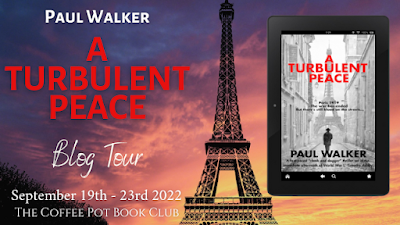 |
| Welcome to my Blog! Wander through wonderful worlds real and fictional, meet interesting people, visit exciting places and find a few good books to enjoy along the way! |
Rue Gustave Courbet presented as a typical residential street in central Paris; a paved road edged by six-storey cream plastered terraces, double wooden doors and shuttered windows for apartments, alternating with shop fronts, cafes and offices. The mid-afternoon sky had darkened, and the few pedestrians paid me little attention as they busied themselves, wrapped tightly into their collars and scarves. I passed number 18 mid-way on my right, continued to the end of the street and crossed to the other side. I walked back until I was opposite number 18 and stared into the reflection of a shop window. I saw five lights in windows on the second, third and fourth floors, but light was no sure indication of current occupation. I had resolved to take a seat in a nearby café to consider my next move when the door opened, and an elderly man appeared, gazed uncertainly at the sky and prodded a walking stick on to the pavement. There was my chance. I moved quickly over the street, with a hailed warning that the pavement was icy, offering him my arm to step out safely. He was surprised but grateful and grabbed my coat before placing a hesitant foot over the doorstep. I swung the bag off my shoulder with my other arm and put it behind him to stop the door from closing. We took a dozen steps together before I assured him it was safe to continue without my assistance. I watched as he progressed slowly, then I returned to number 18, picked up my bag and entered the hallway.
A single electric bulb lit a dim lobby and stairwell. The door to my left showed a brass letter A, and I assumed the unmarked door to my right was the domain of the concierge. I stilled myself and listened for any sounds of activity, holding my breath in the chill, bare space. Satisfied, I raised my heels and trod carefully up the stairs, grabbing my bag and coat tightly to deaden any rustling from cotton and silk. Apartment E was on the second floor. I tapped the door and waited. Nothing. I removed a white glove and knocked again; the sound echoed, brazen and harsh in the shadowy void of the stairwell. An ear to the door yielded only silence. What should I do? I cursed my lack of preparation; should have written a note in advance to slip under the door. I twisted the door handle in frustration. Was it unlocked? I pushed gently and the door opened.
As soon as I entered, I knew what I would find. The smell of death had become too familiar. I hesitated. Why wasn’t I terrified? I felt a curious mix of nervous anticipation and calm certainty that I should explore the apartment. With a handkerchief to my face, I made my way along a dark corridor to a large room with pale grey light filtered through two windows. I flinched as I caught movement before realising it was my reflection in a full-length mirror. A large table and six chairs occupied the central space. An embroidered white cloth was arranged in a diamond shape on the tabletop, and a blue vase in the middle held an arrangement of dried flowers. Four easy chairs were set around a hearth at the far end with spent coal in the grate, and a neat stack of newspapers topped a smaller table. I examined a few. They were all Le Figaro, in date order with the most recent dated six days ago.
Four doors led off the main room; the nearest was half-open. I pushed slowly. A bedroom. An overturned cupboard. A trousered leg on a crumpled bed. I took a breath and entered a scene of bloody murder. A man formed a grotesque shape on the bed: arms outstretched; a hand raised with a finger pointing to the ceiling; one leg folded at an awkward angle underneath the other; his head hidden under a pillow covered in dried gore. I stood in the doorway, closed my eyes and steeled myself for a closer inspection. At hospitals, I dealt with the dead and dying in an environment far removed from the actions that caused their wounding or death. This was different. I bore witness to the immediate aftermath of an intimate and deliberate killing. I approached the body and tried to lift the pillow. Stuck to the head. I tugged, then wrenched, and it tore, leaving shreds of cloth around a gaping head wound. I imagined the scene; a terrified man held by strong arms, the pillow suffocating; one shot through the pillow into the forehead. Maybe a muffler or silencer was attached to the gun. It was not the work of one man. I don’t know why, but I had an impression the mission was completed quickly and efficiently by at least three killers.
The mottled features with staring eyes, screaming mouth, and bulging tongue told me nothing. A short, thickset man in his forties with flecks of grey in his hair and moustache, I guessed he had been dead for two or three days. The cut and cloth of a dark suit were workaday, and a fob watch in his waistcoat pocket showed the name of a Swiss maker. I hesitated, took a deep breath, then opened the suit jacket to reveal the name of a French tailor but found no wallet inside.
I knew I should examine the body but looked away to suppress a feeling of nausea. Could I get clues on identity in another, more agreeable, way? I righted the cupboard and examined the drawers, two shirts in one: underclothes in the other. The initials A.C. embroidered in the shirts offered a tantalising clue to a name, but I needed more. Two suits and an overcoat in a small wardrobe revealed nothing about their wearer, so I moved back to the main room.
The next door was closed. I braced myself for another prospect of horror before opening. An anti-climax. Another bedroom, unoccupied, with everything neat and orderly except for a rumpled blanket on top of the bed. The wardrobes and cupboards were much the same as the other bedroom, with more shirts and underclothes, two pairs of boots and two fur hats, but no initials to offer clues to a name. A hairbrush, comb and small framed photograph of a middle-aged woman lay on top of the cupboard. Nothing was gained from what was clearly a studio photograph, with no inscription and an anonymous background.
Where was the second man? Had he escaped the terrible fate of his fellow resident? He may be an occasional lodger, or surely, he would have reported his death. Perhaps he could have met a similar fate, but at another location. Unless - he was one of the killers. No, that was unlikely. The sparsely furnished apartment gave the impression of a temporary residence, inhabited by men who had a cordial relationship at the very least.
 |
| When the Mermaid Sings : https://viewbook.at/WhenMermaidSings |
 |
| buy from Amazon https://getbook.at/MirrorMurder |









Thank you very much for hosting Paul Walker with A Turbulent Peace today. Much appreciated. xx
ReplyDeleteThanks for hosting this excerpt, Helen.
ReplyDelete